英语会话含义分析
- 格式:doc
- 大小:39.50 KB
- 文档页数:3
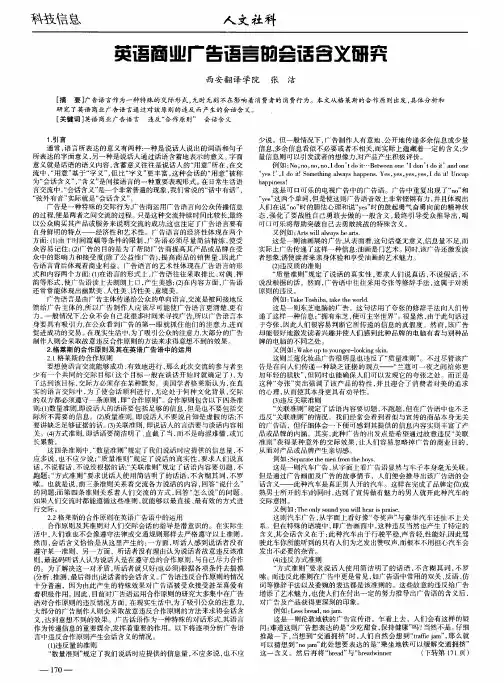
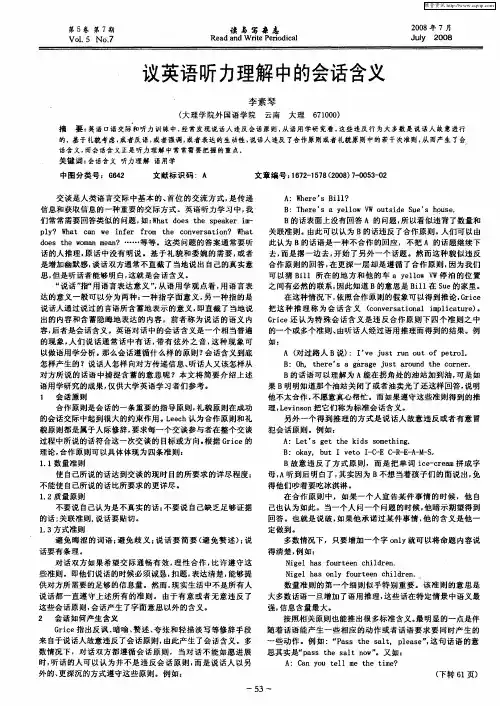
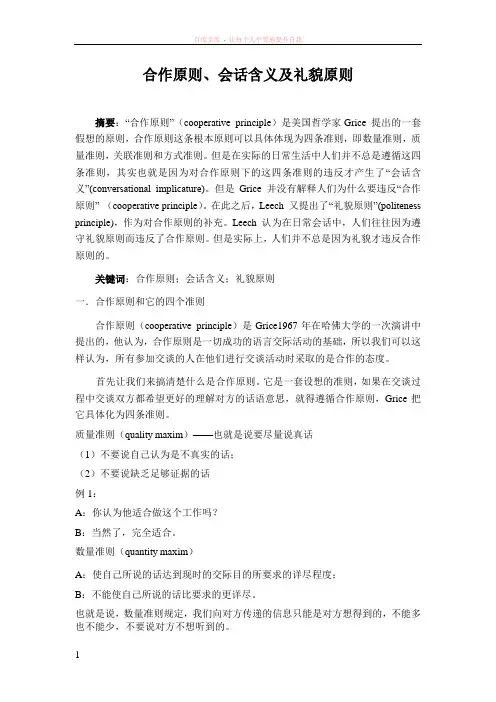
合作原则、会话含义及礼貌原则摘要:“合作原则”(cooperative principle)是美国哲学家Grice 提出的一套假想的原则,合作原则这条根本原则可以具体体现为四条准则,即数量准则,质量准则,关联准则和方式准则。
但是在实际的日常生活中人们并不总是遵循这四条准则,其实也就是因为对合作原则下的这四条准则的违反才产生了“会话含义”(conversational implicature)。
但是Grice 并没有解释人们为什么要违反“合作原则” (cooperative principle)。
在此之后,Leech 又提出了“礼貌原则”(politeness principle),作为对合作原则的补充。
Leech 认为在日常会话中,人们往往因为遵守礼貌原则而违反了合作原则。
但是实际上,人们并不总是因为礼貌才违反合作原则的。
关键词:合作原则;会话含义;礼貌原则一.合作原则和它的四个准则合作原则(cooperative principle)是Grice1967年在哈佛大学的一次演讲中提出的,他认为,合作原则是一切成功的语言交际活动的基础,所以我们可以这样认为,所有参加交谈的人在他们进行交谈活动时采取的是合作的态度。
首先让我们来搞清楚什么是合作原则。
它是一套设想的准则,如果在交谈过程中交谈双方都希望更好的理解对方的话语意思,就得遵循合作原则,Grice把它具体化为四条准则。
质量准则(quality maxim)——也就是说要尽量说真话(1)不要说自己认为是不真实的话;(2)不要说缺乏足够证据的话例1:A:你认为他适合做这个工作吗?B:当然了,完全适合。
数量准则(quantity maxim)A:使自己所说的话达到现时的交际目的所要求的详尽程度;B:不能使自己所说的话比要求的更详尽。
也就是说,数量准则规定,我们向对方传递的信息只能是对方想得到的,不能多也不能少,不要说对方不想听到的。
例2:A:这学期你修了几门课程?B:五门。
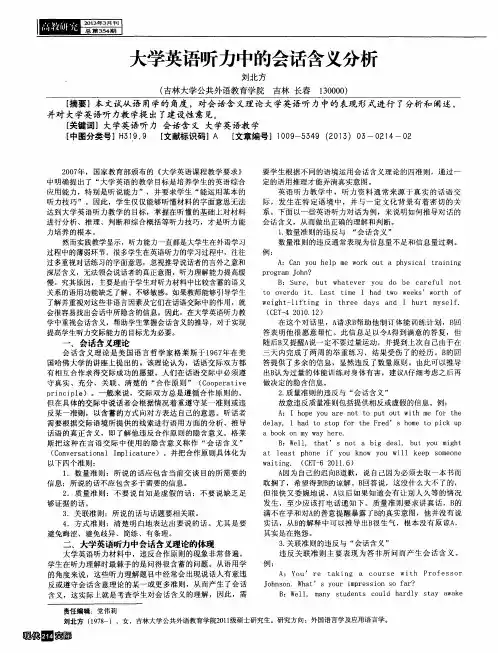

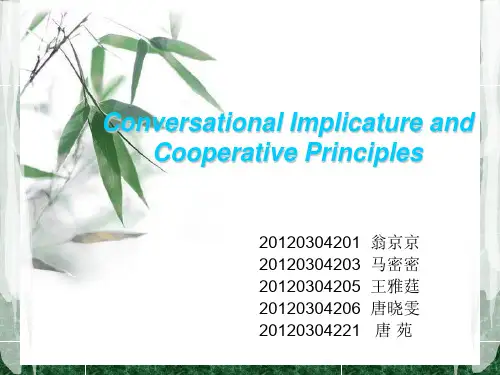
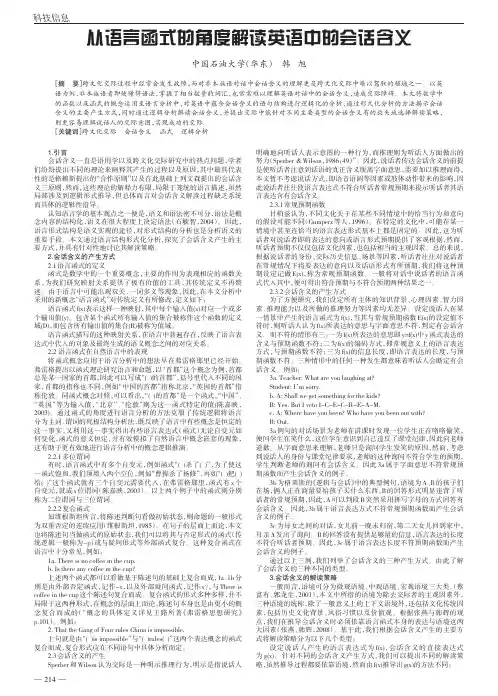
科技信息1.引言会话含义一直是语用学以及跨文化交际研究中的热点问题,学者们纷纷提出不同的理论来阐释其产生的过程以及原因,其中最具代表性的是格赖斯提出的“合作原则”以及在此基础上列文森提出的会话含义三原则,然而,这些理论的解释力有限,局限于笼统的语言描述,虽然局部涉及到逻辑形式推导,但总体而言对会话含义解读过程缺乏系统而具体的逻辑性指导。
认知语言学的基本观点之一便是,语义和语法密不可分,语法是概念内容的结构化,语义在很大程度上决定语法(石毓智,2004)。
因此,语言形式结构是语义实现的途径,对形式结构的分析也是分析语义的重要手段。
本文通过语言结构形式化分析,探究了会话含义产生的主要方式,并具有针对性地讨论其解读策略。
2.会话含义的产生方式2.1语言函式的定义函式是数学中的一个重要概念,主要的作用为表现相应的函数关系,为我们研究映射关系提供了极有价值的工具,其传统定义不再赘述。
由于语言中可能出现双关、一词多义等现象,因此,在本文分析中采用的新概念“语言函式”对传统定义有所修改,定义如下:语言函式f(x)表示这样一种映射,其中每个输入值(x)对应一个或多个输出值(y)。
包含某个函式所有输入值的集合被称作这个函数的定义域(D),而包含所有输出值的集合(R)被称为值域。
语言函式描写的这种映射关系,在语言中普遍存在,反映了语言表达式中代入的对象及最终生成的语义概念之间的对应关系。
2.2语言函式在自然语言中的表现将函式概念应用于语言分析中的想法早在弗雷格那里已经开始。
弗雷格提出以函式理论研究语言和命题,以“首都”这个概念为例,首都总是某一国家的首都,因此可以写成“()的首都”,括号里代入不同的国家,首都的指称也不同,例如“中国的首都”指称北京,“英国的首都”指称伦敦。
同函式概念对照,可以看出,“()的首都”是一个函式,“中国”、“英国”等为输入值,“北京”、“伦敦”则为这一函式特定的值(陈嘉映,2003)。
通过函式的角度进行语言分析的方法克服了传统逻辑将语言分为主词、谓词的死板结构分析法,既反映了语言中有些概念是恒定的这一事实,又利用这一事实得出有些语言表达式(函式)无论自变元如何变化,函式的意义恒定,并有效模拟了自然语言中概念嵌套的现象,这有助于更有效地进行语言分析中的概念逻辑推演。
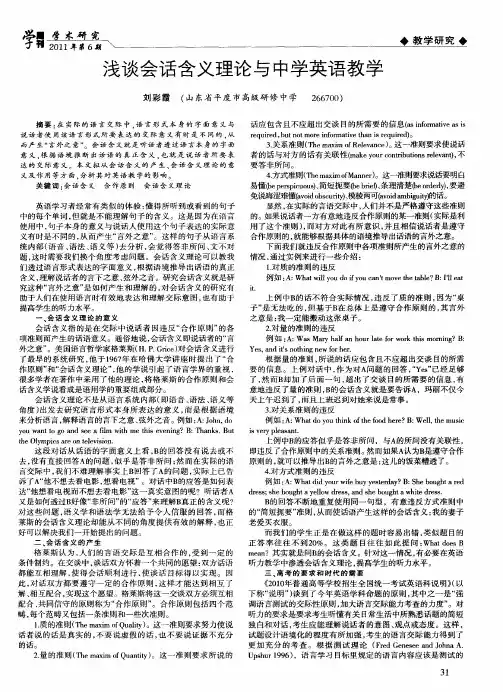
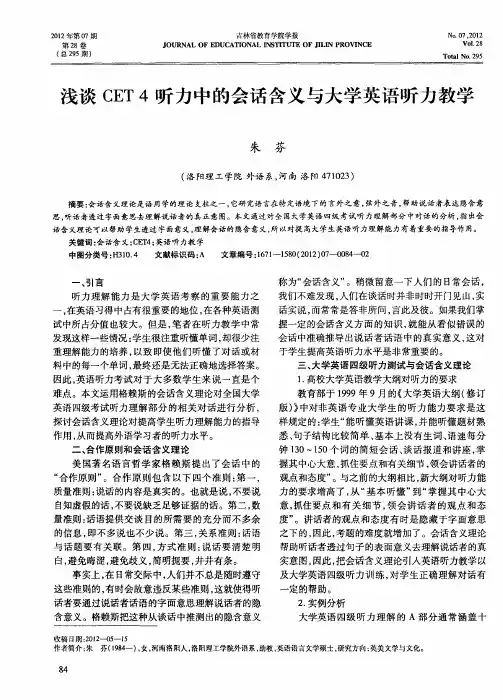
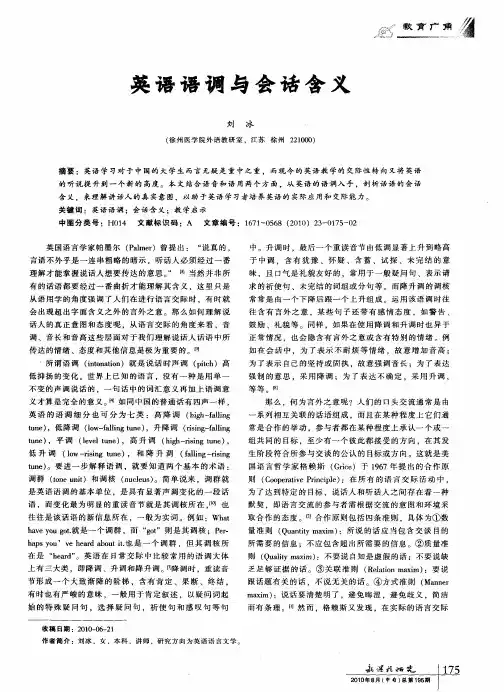
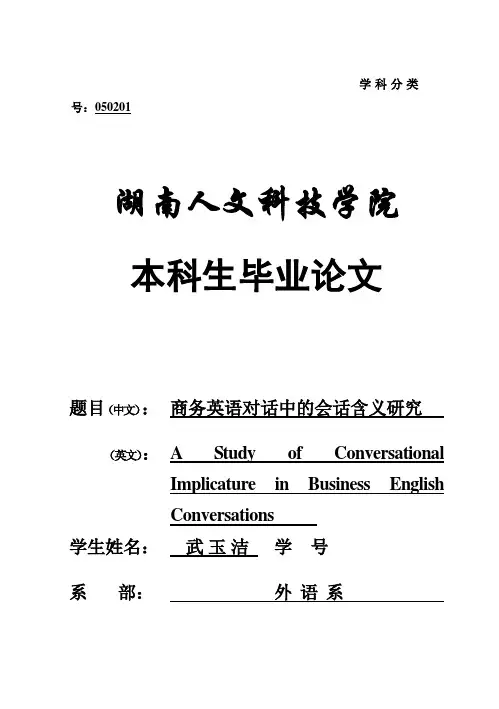
学科分类号:050201湖南人文科技学院本科生毕业论文题目(中文):商务英语对话中的会话含义研究(英文): A Study of ConversationalImplicature in Business EnglishConversations学生姓名:武玉洁学号系部:外语系专业年级:英语专业2010级指导教师(姓名):朱芙蓉(职称):副教授湖南人文科技学院教务处制A Study of Conversational Implicature in Business EnglishConversationsBy Wu YujieMay 15, 2014内容摘要商务英语作为专门用途英语的一个分支,用词简短易懂,句式严密规范,语篇实用性强,是在特殊语境下使用的一种语言。
包括商务英语谈判、商务英语信函,商务英语礼仪及其他众多方面。
会话是商务运作中建立关系或达成一致的最常见的方式。
通过会话商务合作双方可以相互理解对方并取得有利信息。
在言语交际中,人们通常会共同努力达成某种共同的目标或者努力让会话向期望的方向发展。
会话双方都相信彼此说话时是相互配合的。
然而人们并非总是合作的,有时候会故意违反会话指导原则,即合作原则。
在语用学的合作原则的视角下对会话进行研究和分析不仅可以使人们意识到言语交际的内在规律,提高人们的口头交际能力,还能从日常会话中常见的、从未被注意的现象中发现人们理解和把握世界的方法,揭示语言的本质。
关键词:商务英语对话;会话含义;合作原则AbstractBusiness English, as a branch of English for special purpose (ESP) is brief and concise in word use ,vigor and normative in sentence pattern, high functional in context. Business English contains Business English negotiation, English business correspondence, Business English etiquette and so on. Business English Conversation is a common way in business trade for setting up relationship or making a deal. According to the conversation, both parties involved have a better understanding of each other and get mutual benefit .In social communication, both sides usually attempt to work to achieve their shared goal and try hard to let the conversation go on as they expect. But sometimes, people won’t cooperate with each other for some reasons, they will violate the guiding principle of conversation---cooperative principle.The study and analysis of conversation under the perspective cooperative principle of pragmatics not only helps us realize the speech communication rules and improve our oral communication ability, but also reveals the way we understand and master the world from the familiar yet unnoticed daily conversational phenomena, and uncovers the essence of language as well.Key Words:Business English conversation; conversational implicature;Cooperative PrincipleContentsIntroduction (1)1.Theoretical Framework (2)1.1 A Brief Introduction to Conversational Implicature (2)1.2 A Brief Introduction to Grice’s Cooperative Principle (3)2.Features of Business English Conversations (6)2.1 Adaptation (7)2.2 Accuracy (8)2.3 Timeliness (8)2.4 Face-to-face conversations (9)3.Conversational Implicature in Business English conversations (9)3.1 Factors Affecting Conversational Implicature (10)3.1 .1 Factor of the Context (10)3.1.2 Factor of Politeness (12)3.2 Conversational Implicature by Violating Cooperative Principles (12)3.2.1 Violating the Quantity Maxim (13)3.2.2 Violating the Quality Maxim (16)3.2.3 Violating the Relation Maxim (19)3.2.4 Violating the Manner Maxim (20)Conclusion (22)Notes (25)References (2)IntroductionPragmatics is a special branch of linguistics because its interpretation depends more on who the speaker of the sentence is, who the hearer is, when and where it is used . In short, pragmatics depends more on the context.The theory of conversational implicature is one of most famous theory of Pragmatics. Grice. H. P, one of the world most distinguished scholars in Pragmatics, brings forward the conversational implicature theory with cooperative principle and its four conversational maxims in “Logic and Conversation”, and tries hard to “explain how a hearer gets from what is said to what is meant, from the level of expressed meaning to the level of implied meaning”[1]and indicates that people frequently generate conversational implicature by violating cooperative principle. So, conversational implicature is indirectly associated with linguistics content of utterances. It’s necessary for a English business trader to learn the implied meaning from whatis delivered by speaker.Conversation is a most useful way for participants to deliver and obtain information. In communication, participants usually try hard to achieve the same goal or make the conversation develop to the direction as they expected. Business English conversation is a carrier of international business trade .A successful business English conversation is the result of effective team work. In order to make the communication fulfill, the participants should have one common goal, or at least one common direction accepted by all the participants. Usually these goals or directions are definitely set at the starting of the whole conversation[2]. For instance, two parties prepare to make an agreement of the meeting time, solve a specific problem, and then people make efforts in cooperation to realize the goals and directions.Pragmatics as a relatively new area in linguistics has already obtained great attention among linguists all over the world but there only few search in business area. By analyzingbusiness conversations in a pragmatic approach, I hope, I can make certain contribution to correctly understand the conversational implicatures in business English conversations and help people in business English conversations and shed light on the application of pragmatics.1.Theoretical FrameworkGrice’s conversational implicature theory and cooperative principle with its four maxims is employed as the theoretical framework to study the conversational implicature in business English conversations.1.1 A Brief Introduction to Conversational ImplicatureThe theory of conversational implicature was proposed by Oxford philosopher Herbert Paul Grice. Grice began to formulate his ideas of this theory in the 1950s, but it was known through the William James’lectures which he delivered at Harvard in 1967. Part of the lectures was published in 1975 under the title of “Logic and Conversation”.A speaker conversationally implicates that Q by saying that P if and only if he or she is conforming to the CP in saying that P , and the explanation of his or her conformity to the CP is that he or she thinks that q, and he or she thinks that the hearer will recognize that it his or her thinking that q explains his or her conformity to the CP [3] .It has long been recognized that the one-to-one relationship between its linguistic form and what a speaker truly means does not exist so that a distinction between the literal meaning of what a person says and its implied meaning is often created in daily communication. The following is an example of the conversational implicature meant by Grice:Lily: Do you have any money on you?Here, the speaker’s implied meaning is to wish the listener understand that she wants to borrow some money from the listener.So from the above example we know that the conversational implicature is a message not found in the surface meaning of the sentence, but implied in a deep level.Conversational implicature is indirectly associated with the linguistic content of utterances. So it is essential for us to learn the implied meaning from what is conveyed in some context. 1.2 A Brief Introduction to Grice’s Cooperative PrincipleIn conversational exchange people usually try to reach a common goal by mutual efforts or at least make the conversation to develop in the direction of their expectation. H. P. Grice has found some rules that apply and work in human conversation and established his theory of Conversational Implicature. Grice proposed that all speakers, regardless of their cultural background, adhere to a basic principle governing conversation which he termed the cooperative principle. That is, we assume that in a conversation the participants will cooperate with each other when making their contributions. Grice once defines the cooperative principal as following: “you’re your contribution such as is required, at the stage which it occurs, by the accepted purpose or direction of the exchange in which you are engaged[4].”People act in conversation in accordance with a generalprinciple that they are mutually engaged in an activity that is of benefit to all, especially helpful for mutual understanding.Cooperative principle is the core of Grice’s conversational implicature. In further explaining the cooperative principle,Grice subdivides this general principle into four more detailed maxims. They are: quantity maxim, quality maxim, relation maxim and manner maxim. And the content of each maxim is as follows:The first basic maxim is the maxim of Quantity: concerned with the quantity of information to be provided and has two sub-maxims:Make your contribution as informative as is required (for the current purposes of the exchange).Do not make your contribution more informative than is required.The second basic maxim is the maxim of Quality: try to make your contribution one that is true and more specific: Do not say what you believe to be false.Do not say that for which you lack adequate evidence.The third basic maxim is the maxim of Relation:”be relevant”. This maxim can be interpreted as making sure what you say is relevant to the conversation at hand. The point of this maxim is that it is not sufficient for a statement to be true for it to constitute an acceptable conversational contribution.The fourth basic maxim is the maxim of Manner : be perspicuous.Avoid using obscurity and hard-to-understand words to expression;Avoid using ambiguous to expression;The sentence use to express oneself must be brief and avoid unnecessary prolixity;That the sentence use to express oneself must be orderly.In short, these maxims specify what participants have to do in order to converse in a maximally efficient, rational, cooperative way: they should speak sincerely, relevantly and clearly, while providing sufficient information.It should be noted that the above maxims are not rules. They are much more flexible, more like guidelines. Infringing arule of grammar leads to an ill-formed utterance; however, the maxims can be creatively infringed and are to be followed by and large, to the best of one’s ability. Grice is at pains to emphasize that the maxims are not culture-bound conventions like table manners: they are rationally based, and would hence be expected to be observable in any human society. One way in which cultures can differ is in the relative importance allotted to the maxims. For instance, a strict adherence to the maxim of quality may lead to no information at all being given. In some cultures, this may come across as rudeness, and to avoid this result, it may be preferable to provide fictitious information in order to make up a seemly response.In Grice’s opinion, implicatures cannot be inferred in a semantic way. They are based on both the content of the utterance and some specific assumptions about the cooperative nature of ordinary talk exchanges. These inferences or conversational implicatures exist in at least two distinct ways: one is the speaker’s following the maxims adhering to the cooperative principle; another is the speaker’s violating themaxims deliberately. If the participants both have the expectation to achieve a successful conversation, they must cooperate with each other, and speak sincerely, sufficiently, relevantly and clearly. To put it another way, they must observe the cooperative principle and the maxims of Quality, Quantity, Relevance and Manner. If someone who participate the conversation flouts the cooperative principle and any of the maxims, he must have intended to do so. And the receiver can infer the speaker’s intended meaning in particular contexts. 2.Features of Business English ConversationsBusiness English conversations have some features. They are adaptation, accuracy, timeliness and communicative function. As the business communicators in a conversation, he or she uses tool conversation carefully and with consideration of their customers and their intended conversational goals. Effective business communicators will find that their efforts pay off in better relationships and business success.2.1 AdaptationBecause of the cultural differences, the communicator inbusiness English conversations must have a good knowledge of the others’ working background and supply proper information.Business English conversations are different from normal conversation because of their adaptation and specification. “The more specific conversations are, the more they meet the needs of the audience” [5].Therefore, before coming to business English conversations, communicator should be clear about the background knowledge of the group people they would talk with, and the content they would convey to their audience.Even in small organizations, it is wrong to assume that everybody will have the same needs, interests and desires when it comes to business conversations. Business conversations are adapted to meet the needs of specific listeners or audiences. Employees working in an administrative setting, for instance, will have different needs and different access to information than employees working in a manufacturing environment. That’s why the communicator in business English conversations must have a good knowledge of the others’ working background and supply proper information.2.2 AccuracyDue to the special prosperities of business conversation, participants are reaching a common goal by mutual efforts. So, the delivered information needs to be clear and concise enough.When information is inaccurate, it will its credibility and cause many troubles. The people who send the information also lose its’credibility. So the sender must be sure about the information sent is accurate in business English conversations. The accuracy includes the context conveyed and expressions that include grammar, spelling and punctuation.2.3 TimelinessAll the employees need to know what is going on in their organizations and in the external environment that impacts them which is good for their future plan especially in business English conversations. The content one conveyed in business English conversations should be in time with the new changes or development in or outside his company or organization, for building a timely and harmonious business relationship. “Today’s technology-driven environment makes it morechallenging than ever before for businesses to communicate with employees in a timely manner, but it is critical for effective business conversation” [5].In addition, it cannot be assumed that a message has gotten across if it is sent just one time. Business conversations occur frequently to ensure that they have been received by all employees. Employees leave, new employees join the company and employees transfer from one role to another, requiring new and updated information in time.2.4 Face-to-face conversations“Face-to-face conversations are still the most effective and should be used whenever possible and practical”[6]. It means that via Face-to-face communication, the speakers talk in person with the listeners and they will fulfill maximize the communicative function. Of course, in very large organizations this can be challenging, but alternatives can be videoconferencing or the use of webinars. In face-to-face business conversations, employees can get the opportunity to share their feedback, opinions and thoughts with managers andemployers. Effective business conversations offer the opportunity for two-way communication to benefit employees and employers.Face-to-Face business English conversations give the conversation listeners a chance to make a two-way interaction. As the speakers, they can understand more about the requirements of the listeners and listeners also can express their suggestions.3.Conversational Implicature in Business EnglishconversationsOn account of reducing misunderstanding in Business trade, hearer must completely understand the speaker’s meaning. So, Business English conversations will be analyzed under the guidance of Grice’s conversational implicature theory.Before that, affecting factors of conversational implicature must be talk as firstly.3.1 Factors Affecting Conversational ImplicatureFactors of context and politeness play an important role in under standing implicatures in business English conversationsand they will be introduced separately.3.1 .1 Factor of the ContextSince the 1970s, linguists at home and abroad have been increasingly aware that context plays a significant and irreplaceable role in deducing conversational implicature. Context is both the basis of correct communication and the foundation of understanding conversational implicature, which helps the participants in a conversation eliminate the vagueness of utterance, deduce the real meaning of the utterance and make up the omitted information. Context, in particular, is helpful when one party wants to grasp the implied meaning of the other who violates the conversational maxims. Grice has realized that the context of the utterance and the background knowledge are important. The following are examples:It is on a Monday morning. Emma comes to Bob’s company and meets Bob. They already collaborated for several times before.Emma: What about payment?Bob: L/C.In this conversation, it seems that Bob doesn’t give the proper answer to Emma, because L/C still can be divided into different types, such as revocable L/C, irrevocable L/C, confirmed L/C, unconfirmed L/C, sight L/C and usance L/C and so on. Some detailed information about the L/C should be told. But when we look at the notes of the conversation, it’s easy to find out Emma and Bob are familiar with each other. Therefore, Bob’s answer is easy for Emma to accept and imply meaning is the method of payment as usual.If the two parties in business are not familiar with each other then one better reply should be:Emma: What about payment?Bob: I suggest the most suitable arrangement should be by an L/C, valid for 10 days, that is until 15 May.Context is a vital ingredient when analyzing the conversational implicature. On one hand, to judge whether an implicature is made or not, or what it implicates, one needs to review what has been said and preview what will be said later to figure out what is going on around. On the other hand, toimplicate something, one may try to invoke the cooperative principle by a word, phrase or statement that may be superfluous, false, irrelevant or fuzzy.3.1.2 Factor of PolitenessIn 1980s, English famous linguist Leech gave a further promotion in Grice’s the cooperative principle and proposed the theory of politeness principle. Politeness principle is a supplement to Grice’s cooperative principle. Leech pointed out that politeness principle is used for people who violate the cooperative principle for polite reason.The theory of politeness principle includes the following five maxims: Generosity Maxim; Modesty Maxim; Agreement Maxim; Sympathy Maxim. These five maxims all provide much convenience for others even though one may suffer losses.For instance, Mary and Lily are bosom friends, and one day Mary speaks to Lily very politely like: “Excuse me, would you mind me closing the window?”Then an idea may take its shape that there might be something unhappy taking place between Mary and Lily and they are still angry with each other.3.2 Conversational Implicature by Violating Cooperative PrinciplesIn the actual verbal business conversational activities, strict observance of the cooperative principle may lead to business termination in some cases or may cause embarrassment on both sides. Thus, appropriate and subtle deviation from the cooperative principle can avoid embarrassment and misunderstanding of each other, help people to better achieve the conversing purpose and successfully complete their verbal conversations.Conversational implicature are all expressed by violations of cooperative principle. They are grouped into four categories in accordance with the four conversational maxims.3.2.1 Violating the Quantity MaximAccording to the opinion of Grice, people should know that it is polite to have a good cooperation with each other in a conversation so that they can make their conversation go successfully. However, in real negotiation, the participants violate cooperative principle by offering purposefully ordeliberately. It is true that people violate the quantity more or less information than is required, which leads the hearer to conjecture the reasons. With the information that has been known and some background knowledge in conversations, the hearer may know the real meaning conveyed by the speaker.The first sub-maxim of the quantity maxim is to make your contribution as informative as is required (for the current purposes of the exchange). In other words, a speaker might tend to offer less information than is required for certain reasons. In a conversation, if a speaker avoids providing sufficient information intentionally, he probably tries to conceal something or disclose more than the literal meaning. Some cases concerned with this point will be studied as follows:It is on a Monday morning, Tina comes to Lee’s company and meets Lee. They talk for more than one hour and then it’s time to talk about the payment.Tina: What about payment?Lee: Er, L/C.In this conversation, it seems that Lee doesn’t give theproper answer. Lee say:“er...”from his word, some conversational implicature you can be seen; he actually means that “You don’t know we need you to pay by L/C surprise me”! But he doesn’t say it directly, in fact, Lee then may know that Tina is a newer of the other party. According to the context, Lee’s answer is understandable, because they are acquainted cooperative partners so that they do not have to mention the payment. The problem is that Tina is new in his company. If the two parties in business are not familiar with each other then one better reply should be:Tina: What about payment?Lee: I suggest the most suitable arrangement should be by an L/C, valid for 30 days, that is until 30 October.From this conversation, it is also can be seen that the new employee Tina is not well-prepared for his conversation and have a ill understanding of his business partner’s company (the first principle in effective method for business English conversations). That’s one important reason for his asking question “What about payment”.In comparison with the violation of the first sub-maxim of the quantity maxim by offering less information, the case offering more information also exists. The extra information, at times, can be perceived as “supportive move”.As usual, Norwich cannot give his trust on one Trust Company hotheadedly and hurriedly. He has to know the credit situation of the other side.Norwich: What about the credit standing?Lance: For our credit standing, Please refer to the Bank of China. Guangzhou Branch. Our enterprise credit is also known to all.In this conversation, Norwich wants to know the corporate credit situation of Lance. Obviously, Lance’s answer: “For our credit standing, please… Branch” is enough. However, later on, he adds some extra words “Our enterprise credit is also known to all”. Lance provides the extra information to Norwich. It is clear that Lance violates the quantity maxim. “Do not make your contribution more informative than is required”[7]. From this sentence, it is easy to deduce the implied meaning: Ourcorporate credit is very good, not only the bank can prove that our company enjoys a high reputation; we also win the business credit in many cooperative companies and partners.Lance must be a qualified trust representative of his company. He knows what the customer needs, what the customer should be told (complete understanding the listeners or askers). That’s why he succeeds in this conversation.Thus, in business negotiations, sometimes one party intends to provide some extra information to the other party, which can make the other party understand their situation in a mufti-faceted, mufti-angled way. Negotiating in this way can not only increase the trust on each other, but also express their sincerity in cooperation.3.2.2 Violating the Quality MaximThe quality maxim requires the speaker to make a true contribution. If a speaker says something that he believes to be untrue or something for which he has no sufficient evidence, then he may implicate something, and consequently conversational implicature appears. In business Englishconversation, participants always use rhetoric to violating the Quality Maxim.Firstly, Irony is used to violate the quality of the quality maxim. G. Leech, in his A Survey of the Interpersonal Rhetoric, pays much attention on irony. In 1983, Leech proposes: The Irony Principle (IP) takes its place alongside Cooperative Principle and the Politeness Principle in the interpersonal rhetoric. Nevertheless, the Irony Principle is parasitical on the other two and is a second-order principle which enables a speaker to be impolite while seeming to be polite; it does so by superficially breaking the Cooperative Principle, but ultimately upholding it. By using irony, we are ironic at someone’s expense, scoring off others by politeness that is obviously insincere, as a substitute for impoliteness. The insincerity may be more or less obvious; it may take the form of a breach of the Quantity Maxim or more often of a breach of the Quality Maxim [8].Miss Chen: Look, everyone is beautifully dressed tonight!Miss Pan: Yes, different from working days.Miss Chen: And Y ang is more beautiful today!Miss Pan: Yes! More beautiful than before! She is really dressed to the teeth!Here, Miss Pan violates the quality maxim by saying “She is really dressed to the teeth”! She truly means: Miss Yang is dressed so showy or gorgeous that even her teeth in mouth will be dressed. And in this context, Miss Pan’s words implicate her internal feelings like envy or sarcasm. The conversational implicature cannot be correctly deduced without a right understanding of the conversational environment or context. If Miss Chen finds Miss Pan’s jealousy about Miss Yang, she would get the implied meaning, something ironic; otherwise she would lose this point. Context is also a factor to affect conversational implicatures.Secondly, hyperbole is used to violate the sub-maxim of the quality maxim. Leech describes hyperbole as “a case where the speaker’s description is stronger than is warranted by the state of affairs described”[8].Mr. Sun: One customer phones us that the consignment we sent were 2 days later than the date signed on the contract andsomething worse, while unloading, that the quality of the goods is not Class A,that is, our workers have made some mistakes.Mr. Kann Doble: What! They drive me up a wall.Mr. Kann Doble must be very disappointed about his employees or maybe he really cannot understand why this kind of mistakes occurs again and again. Therefore, he uses “drive me up a wall” to express his helplessness. At this time, Mr. Sun may clearly know the difficulty of his company and work harder to gain some help of the other party such as coordinating with the customer, promising that the same mistake will not be made in future, calling for all the employees to do their endeavor to regain credit. Effective business conversations need the speaker to understand the listeners completely and also be well-prepared to act as good listeners.Considering this situation, Mr. Kann Doble is more likely to try dealing with this matter instead of being up a wall.Thirdly, Metaphor can also produce conversational implicature by violating the Quality Maxim. The following are the examples:Mr. Wang: It’s not our price which as you said is low, but it’s your price which is too high. We’re climbing the hill, you know. We’re doing that in a very difficult way and we have made it. But you are just standing there high up on the top and not willing to descend.Mr. Scott: We’ve tried to get closer to you several times and we’re halfway down the hill waiting for you already.Obviously, the two sides during this session have adopted the metaphor of the Rhetoric. The speaker’s words of the session violate the quality criteria. Because the use and understanding of metaphor involves factors such as context and background knowledge that both parties had been consulted on the price, the unreasonable price. At the same time, the use of metaphor is based on the similarities between the two types of things, so we can derive the literal meaning of words the meaning of the session, that is, cooperation in order to deal, Mr. Wang is very difficult to raise price and hopes that Mr. Scott cuts price, while Mr. Scott is also justified on try that Mr. Wang can accept the current price. Thus, the use of rhetorical language can be more。
英语语用学中的会话含义
在英语语用学中,会话含义是指在日常对话中,人们如何通过语境和语言的含义来理解和表达意义。
会话含义是一种复杂的语言现象,它涉及到语言、语境和推理等多个方面。
在会话中,人们使用语言来表达自己的意思,而这些语言的含义并不是简单地指代字面意思。
相反,它们是通过语境和上下文来推断的。
例如,当一个人说“我恨你”时,这句话的字面意思是“我讨厌你”,但在某些语境下,它可能意味着“我非常喜欢你”,或者“我感到很失望”。
会话含义的另一个重要方面是合作原则。
这个原则认为,人们在会话中会遵循一系列准则,以确保对话的流畅性和有效性。
这些准则包括:
1.质量准则:不说假话或没有证据的话。
2.数量准则:提供足够的信息,但不超出所需的信息。
3.关系准则:回答相关问题或提供相关信息。
4.方式准则:清晰、简洁地表达想法。
当人们在会话中遵循这些准则时,他们可以推断出彼此的会话含义。
例如,如果一个人问另一个人“你今天过得怎么样?”而另一个人回答“很好,谢谢”,那么根据合作原则,我们可以推断出这个人今天过得很好。
总之,英语语用学中的会话含义是一种复杂的语言现象,它涉及到语境、语言的含义和合作原则等多个方面。
通过理解会话含义,人们可
以更好地理解和表达自己的意思。
会话含义与合作原则来源:英语专业论文介绍了格赖斯地合作原则和会话含义学说,并通过汉英两种语言中地实例,探讨了合作原则在话含义解读中地作用.b5E2R。
语用学;合作原则;会话含义引言首先把人们地交际行为系统地归结为规律地是美国伯克利加州大学地哲学教授格赖斯().他于年在哈佛大学地一次讲演中,论述了“合作原则”()地具体内容,及其制约“会话含义”()产生地过程.这篇演讲所提出地会话含义学说,在语言学界引起了巨大反响.此后,对这一学说地研究经久不衰,研究成果纷至沓来.p1Ean。
年,英国语言学者及分别在其新作《语用学》与《语用学原则》中,把格赖斯地会话含义学说誉为语用学地一个重要理论.DXDiT。
我国学者程雨民、陈融较为详细地介绍了格赖斯地合作原则和会话含义学说.其后,钱冠连对格赖斯地合作原则和下属各条会话准则提出不同地看法,表现出我国学者在理论探索方面地勇气.另外,刘福长、钱冠连分别从不同地角度,使用合作原则下不同地会话准则,解释一、二个实际问题,起到了理论和实际相结合地示范作用.笔者试图从汉语和英语两个方面、从实证地角度,进一步探讨合作原则在会话含义解读中地作用.二、合作原则和会话含义格赖斯指出,会话是受到一定条件制约地.人们交谈之所以能够顺利进行,是以为双方都遵循一定地目地,相互配合默契.他把说话者和听话者在会话中应该共同遵守地原则称为合作原则.RTCrp。
合作原则包含以下个准则:.量地准则( )()所说地话应包含当前交谈地目地所需要地信息;()所说地话不应包含超出需要地信息..质地准则( ):要说真话()不要说自知是虚假地话;()不要说缺乏证据地话..关系准则( ):要有关联,要切题.方式准则( ):要明白清楚()避免晦涩;()避免歧义;()简明扼要;()井井有条.如果在交际中说话人地话语在表面上违反了合作原则,那么,他可能是故意这样做地,听话人就要根据当时地语境,推断出说话人表面违反合作原则地目地,也就是要明白他违反合作原则地隐含意义.格赖斯把这种在言语交际中推出来地隐含意义称作“会话含义”.5PCzV。
浅析会话含义理论对英语听力教学的启示摘要:在英语的学习中,听力作为一种基本的语言技能越来越受到重视。
然而,听力教学现状却不容乐观。
传统的教学模式课堂气氛沉闷,学生反映淡漠,很难提高学生的听力水平。
听力课堂不应该仅仅只是单一的听力训练,教师应该适当引入一些有助于提高学生听力能力的理论,这样不仅可以激发学生的学习兴趣,还可以提高教学效果。
关键词:会话含义合作原则听力理解1 听力教学现状分析由于当今社会对大学生英语听说能力要求的提高,教学目标就更重视以听说为主的英语实际应用能力。
在大学英语教学过程中,听力教学的目的是培养学生的听力理解能力,领会讲话者的观点和态度,并能进行分析,推理,判断和综合概括。
然而,在实际的教学过程中学生往往忽略了与听力理解关系密切的非语言因素。
在具体的听力理解练习中,许多学生不能理解话语背后的深层含义,从而导致学生对说话者真实意图的理解产生了偏差。
因此,要想准确的理解说话者的意图,必须重视非语言因素,了解它们在话语交际中的作用,找出会话中所隐含的信息,从而领会说话者的真实意图。
本文以Grice 的会话含义理论为依据来阐释会话含义理论对英语听力教学的重要性。
2 理论基础1967年,美国语言哲学家格赖斯首次提出了“合作原则”和“会话含义”理论,着重论述了“合作原则”的具体内容以及如何制约“会话含义”产生的过程。
之后列文森、利奇、徐盛桓等人又对该理论进行了修正和完善,列文森概括了这些研究成果,提出列文森会话含义“三原则”,1991年正式把列文森三原则称之为“新格赖斯语用学机制”。
后来,学者们称之为“新格赖斯会话含义理论”。
从而使格赖斯在二十世纪六十年代提出的“古典格赖斯会话含义理论”(即“会话含义理论”)发展为八十年代的“新格赖斯会话含义理论”。
格赖斯认为,在所有的言语交际活动中为了达到特定的目标,说话人和听话人之间存在着一种默契,一种双方都应该遵守的原则,他称这种原则为会话的合作原则(Coopera-tive Principle,简称CP)。